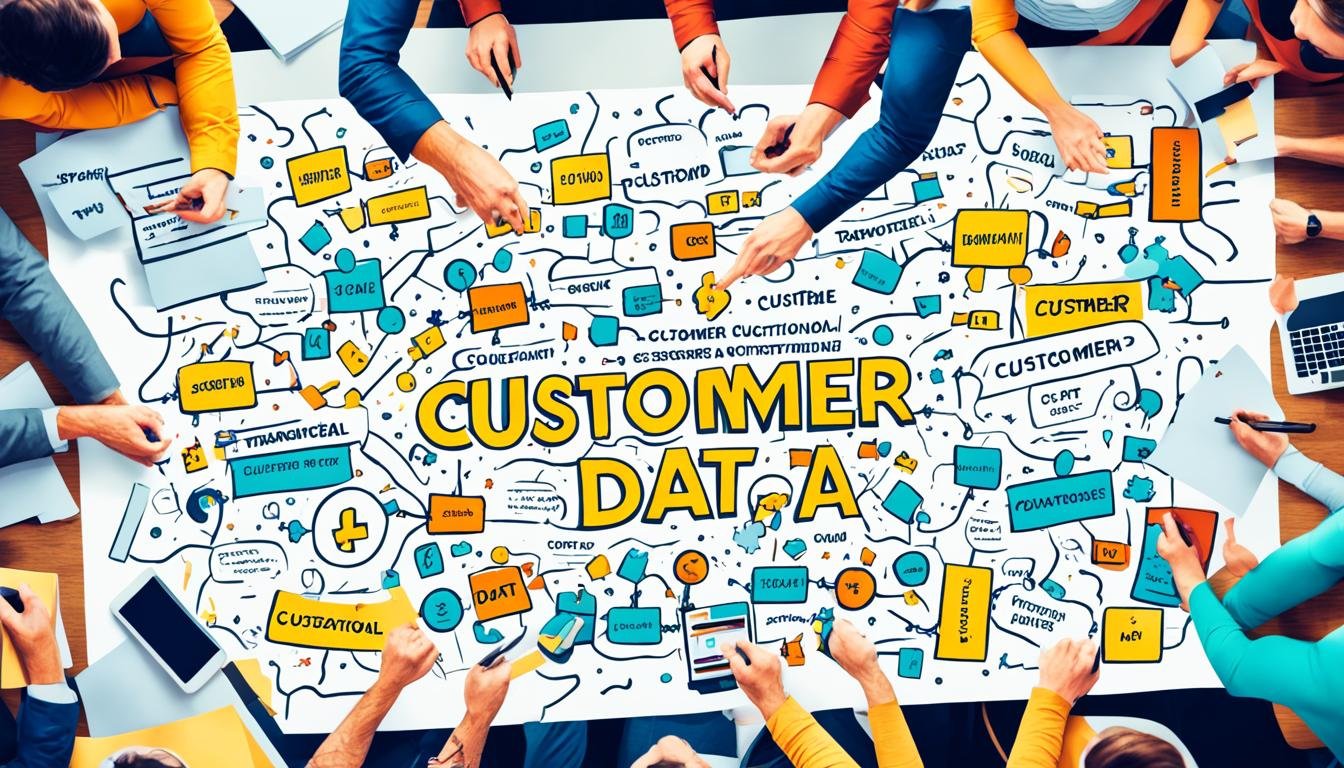First-Party Data Strategies: Importance and implementation.
Did you know that over 66% of people think third-party data about them is not accurate? This shows how important it is for businesses to use first-party data instead. With browsers like Safari, Firefox, and Chrome stopping support for third-party cookies, using first-party data is key for following data privacy laws and finding new marketing ways.
First-party data strategies help make customer profiles that are more accurate. This can cut marketing and sales costs by 10-20%. Also, companies that use first-party data see a 20% higher customer satisfaction rate. This data comes from direct customer interactions on your websites, giving you unique insights that third-party data can’t offer.
Companies like Amazon have faced big fines, like $887 million, for not following GDPR rules. This shows how vital it is to collect customer data ethically. By using first-party data strategies, companies can focus on privacy and stay ahead in the market.
Key Takeaways
- The accuracy of third-party data is increasingly questioned, driving the shift to first-party data strategies.
- Collecting and utilizing first-party data can lead to significant reductions in marketing costs and higher customer satisfaction rates.
- First-party data provides richer insights by being gathered directly from customer interactions with your digital properties.
- Compliance with regulations like GDPR and CCPA is paramount, demonstrated by significant fines for non-compliance.
- A focus on ethical customer data collection fosters trust and can enhance your competitive market position.
Introduction to First-Party Data
In the digital marketing world, first-party data is key for businesses to know and connect with their audience. It comes from direct interactions on websites, mobile apps, and other places where a company meets its customers. With third-party cookies fading away, first-party data is more crucial than ever, giving deep insights.
Defining First-Party Data
First-party data is info collected straight from a company’s customers or users through direct contact. This includes:
- Demographics: Details like age, gender, and where they live.
- Purchase History: A record of what they bought before.
- Website Activity: How much time they spent on pages, and which links they clicked.
This data is reliable and directly related to what a company offers. When customers interact with a business directly, they tend to give more accurate info.
For instance, Omni Hotels & Resorts boosted their ad results by four times with signal-less solutions, showing first-party data’s power. By using these insights, companies can tailor their marketing, engage more effectively, and see better results.
The idea of zero-party data, from Forrester Research, goes hand in hand with first-party data. Zero-party data is when customers share their likes and thoughts with brands on their own. This makes customer data more precise and relevant, since it comes straight from the customer.
Also, owning the data is key with first-party data. Unlike third-party data, which comes from outside sources, first-party data belongs to the company. This means businesses can use it wisely and follow data privacy laws like GDPR and CCPA.
Why First-Party Data Matters More than Ever
In today’s world, with tough privacy regulations like GDPR and CCPA, first-party data is key. It comes from customers directly, like their info, what they buy, and how they use websites. Now, with third-party cookies phase-out on the horizon, thanks to Google’s 2024 plans and Apple’s 2020 move, first-party data is more crucial than before.
Switching to first-party data helps with privacy regulations and makes marketing better. It lets brands offer experiences that really speak to customers. This way, ads hit the mark and product suggestions are spot-on.
First-party data feeds into predictive analytics, helping predict what customers will do next. Knowing what customers buy and how often helps brands tailor their marketing. Tools like customer data platforms (CDPs) bring all this info together for smarter decisions.
With third-party cookies fading away, having a strong first-party data plan is a must. This means getting data through surveys, polls, and quizzes. Combining this with tracking customer behavior makes customer profiles richer. This way, companies stay ahead, follow the law, and keep customers engaged in a changing privacy world.
Benefits of First-Party Data for Data-Driven Decision Making
First-party data gives big benefits for companies wanting to make smart decisions. It lets them understand customers better and improve how they connect with them. This leads to more customer involvement and loyalty.
Enhanced Customer Insights
Knowing what customers like is key for any business. First-party data helps companies get deep insights into what customers prefer and how they interact. This way, they can make products that really meet customer needs.
For instance, analytics on websites help track user behavior. Asking users to register can also give valuable info. A big 88% of marketers say first-party data is more important now for making smart choices.
Improved Personalization Efforts
First-party data takes personalization to a new level. Companies can make personalized marketing campaigns that really speak to each customer. This not only boosts customer interest but also keeps them coming back.
Building databases through newsletters and surveys helps send targeted messages. This way, companies can keep making their products and plans better. They make sure they meet what their customers need.
First-Party Data Collection Methods
Today, companies are focusing on collecting customer data in an ethical way. They use website analytics and surveys to do this. These methods help them follow the law and make customers happier.
Website Analytics
Website analytics give a lot of data on how users act online. With Google planning to stop third-party cookies by 2023, companies are turning to their own data. Tools like event-based tracking show how users interact with content, helping improve the site.
Single sign-on (SSO) makes logging in easier and collects data through systems like Google or Facebook. This helps in understanding users better.
Surveys and Feedback
Surveys and feedback give a direct look at what customers think. Apple’s iOS 14 update lets users block app tracking, showing the need for ethical data collection. Companies use polls and reviews to make their products better.
By collecting first-party data, companies can offer personalized experiences. This approach helps reduce customer loss and builds strong relationships. It also leads to better decisions, helping companies connect with their audience.
Building Trust and Transparency
In today’s digital world, it’s key to build trust with your audience. Showing you care about their data privacy and being open about how you use their data can make you stand out. This trust is the base for long-term success.
Privacy Policies
Having clear privacy policies is a must. They tell customers what data you collect and why. These policies must meet legal standards and be simple for everyone to understand.
Getting clear consent from users is crucial. It shows they know and agree to how their data is used. This keeps trust strong.
To gain trust, be open about how you use customer data. Explain how it makes their experience better, like getting personalized offers. Offering something in return, like special content, can make them more willing to share their data.
Collecting data bit by bit over time can help build trust. Letting users control their data through preference centers also makes them feel secure.
Putting a focus on clear data practices and getting clear consent helps you follow laws like the CCPA or GDPR. It also builds a loyal customer base. A detailed privacy policy shows you care about your customers’ data, making them feel safe and valued. This leads to better business results.
Best Practices for Customer Data Management
Managing customer data well is key to getting reliable insights. It makes sure data is consistent, helps with accurate analysis, and supports making marketing more personal. The main steps are standardizing data and integrating it.
Data Standardization
Standardizing data is crucial to make sure all the info from different places is the same. It means making sure things like names, addresses, and purchase records are recorded the same way. This makes customer insights more accurate.
Having a unified dataset means everyone in the company uses the same info. This leads to better data quality and clarity. In fact, 65% of people are now focusing more on their own data, showing how important standardization is.
Data Integration
Integrating data is a big part of managing customer data well. It brings together info from different places like CRM systems, website analytics, and mobile apps into one spot. This gives a full picture of the customer, helping with more targeted marketing.
For example, CRM systems keep all customer info in one place. This lets companies use tools like Google Analytics and Tableau to find important insights. These insights can then lead to better actions.
Integrating data helps with marketing and making big decisions by showing a complete picture of what customers like. Using data warehouses or Customer Data Platforms (CDPs) makes getting to this info easier and more powerful.
By using data standardization and integration, companies can turn their customer data into a key asset. This helps with growth and success over time.
Implementing First-Party Data Strategies
With third-party data and cookies facing limits due to new rules and privacy worries, it’s time to focus on first-party data. This approach boosts marketing by offering tailored customer experiences, cutting costs, and ensuring data quality. Let’s look at how to put first-party data strategies into action.
Starting with a first-party data plan means setting clear goals that match your business aims. Using first-party data brings many benefits, like better following the rules, improving customer experiences, and making marketing more personal. It’s key to set these goals well.
Setting Clear Goals
When you’re setting up a first-party data strategy, know what you want to achieve. Do you want to keep more customers, make marketing more personal, or improve how you track results? Setting clear goals, like increasing customer retention or making customer experiences better, helps focus your efforts.
- Define audience segments
- Map the customer journey
- Establish metrics and KPIs
- Set reporting periods
- Allocate resources efficiently
Having these goals is vital for checking how well your first-party data strategy is doing and making changes as needed. It’s crucial to set clear goals to start with a strong plan and to adopt customer data platforms well.
Choosing the Right Tools
Choosing the right marketing tech, like customer data platforms (CDPs), is also key. These platforms help collect, unite, and use data across different touchpoints, making customer data platform adoption smoother. The main benefits of using CDPs include:
- Targeting and collecting customer data in one place
- Improving data integrity and compliance
- Getting insights from customer behavior
Using the right tools means picking technologies that help with your data-driven planning and give you the edge to offer unique, personalized experiences. Brands using first-party data for marketing saw up to a 2.9x revenue boost and a 1.5x cut in costs.
As we move away from third-party cookies, focusing on first-party data is more important. Investing in the right tools and setting clear goals will help your business grow and make your marketing more effective.
Leveraging First-Party Data for Personalized Marketing Campaigns
In today’s world, using first-party data for marketing is key. Studies show that personalized content from this data greatly increases customer engagement and satisfaction. Brands can make ads that really speak to customers by knowing their needs and likes.
Targeted ads from first-party data also help keep customers coming back and increase their value over time. Netflix, Amazon, and Starbucks are great examples. They use first-party data to give customers content and offers that matter to them, leading to more loyalty.
Companies that focus on first-party data see better targeting and more sales. Google found that brands using this data for marketing can see up to a 2.9x revenue boost and save 1.5x more. Adding AI and predictive analytics makes these efforts even stronger, leading to more customer interaction and satisfaction. By using these methods, brands can make marketing that really connects with customers and makes them happier.
Source Links
- Privacy regulations: How to build a first-party data strategy
- First Party Data: What It Is & How Marketers Can Leverage It
- How to Develop and Implement a First-Party Data Strategy
- 8 Steps to Create a First-Party Data Strategy
- The ultimate guide to first-party data
- What Is First-Party Data? Building a 1st-Party Data Strategy
- A cookieless future: Why first-party data matters to marketers more than ever | Simon Data
- Build a First-Party Data Strategy for Data-Driven Decisions
- What is first-party data and how does it benefit your marketing
- Why is 1st-Party Data Important?
- The 8 Best Strategies for Mastering First-Party Data Collection
- First-party data strategy: The ultimate guide for marketers – Supermetrics
- First-party data strategy: trends and tips in 2024
- 5 clever & compliant strategies to collect first-party data
- Refine Your First-Party Data Strategy With These 5 Tips | Jebbit
- 12 Steps to Build a Successful First-Party Data Strategy – Storyly
- First-Party Data Strategy: A Blueprint for Marketers
- How to Master Customer Data Management (Best Practices)
- How to Build a First-Party Data Strategy (6 Key Steps)
- 5 Steps to Building a First-Party Data Strategy | AdRoll
- Sustainable first-party data strategy – Think with Google
- How to Leverage First-party Data | The Logit Group
- A Complete Guide to First-Party Data: The Solution to a Cookieless…
- B2B First-Party Data: The Future of Personalization | StackAdapt




